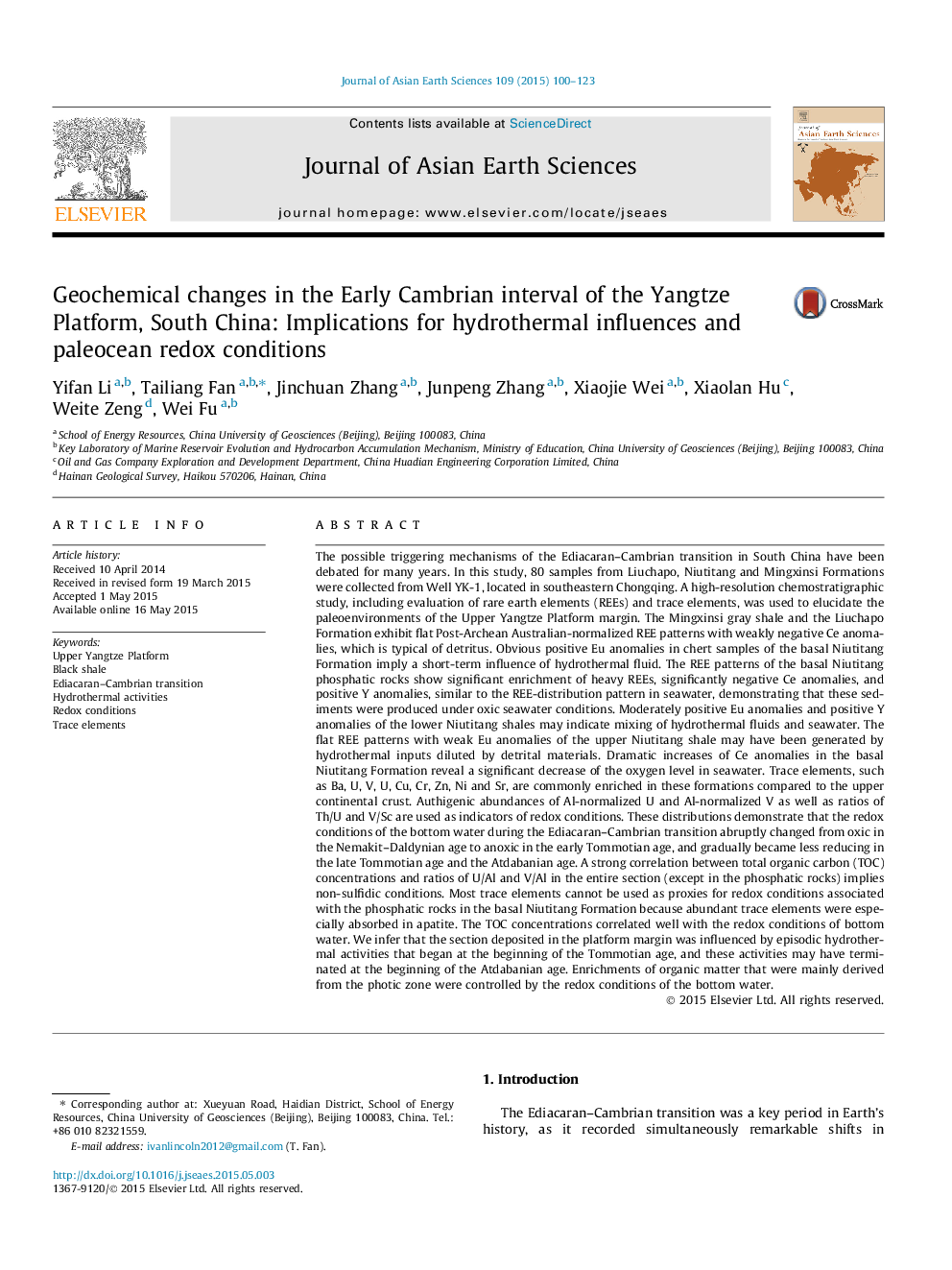| کد مقاله | کد نشریه | سال انتشار | مقاله انگلیسی | نسخه تمام متن |
|---|---|---|---|---|
| 4730428 | 1640360 | 2015 | 24 صفحه PDF | دانلود رایگان |

• REE patterns were used to estimate influences of hydrothermal input.
• Ce anomalies Trace elements were used to establish redox conditions during Ediacaran–Cambrian transition.
• The hydrothermal inputs during the Early Cambrian age represent a combination of several episodic events.
• The bottom water at the beginning of Tommotian age remained more oxic rather than anoxic.
• The redox conditions of bottom waters controlled preservation of organic matter.
The possible triggering mechanisms of the Ediacaran–Cambrian transition in South China have been debated for many years. In this study, 80 samples from Liuchapo, Niutitang and Mingxinsi Formations were collected from Well YK-1, located in southeastern Chongqing. A high-resolution chemostratigraphic study, including evaluation of rare earth elements (REEs) and trace elements, was used to elucidate the paleoenvironments of the Upper Yangtze Platform margin. The Mingxinsi gray shale and the Liuchapo Formation exhibit flat Post-Archean Australian-normalized REE patterns with weakly negative Ce anomalies, which is typical of detritus. Obvious positive Eu anomalies in chert samples of the basal Niutitang Formation imply a short-term influence of hydrothermal fluid. The REE patterns of the basal Niutitang phosphatic rocks show significant enrichment of heavy REEs, significantly negative Ce anomalies, and positive Y anomalies, similar to the REE-distribution pattern in seawater, demonstrating that these sediments were produced under oxic seawater conditions. Moderately positive Eu anomalies and positive Y anomalies of the lower Niutitang shales may indicate mixing of hydrothermal fluids and seawater. The flat REE patterns with weak Eu anomalies of the upper Niutitang shale may have been generated by hydrothermal inputs diluted by detrital materials. Dramatic increases of Ce anomalies in the basal Niutitang Formation reveal a significant decrease of the oxygen level in seawater. Trace elements, such as Ba, U, V, U, Cu, Cr, Zn, Ni and Sr, are commonly enriched in these formations compared to the upper continental crust. Authigenic abundances of Al-normalized U and Al-normalized V as well as ratios of Th/U and V/Sc are used as indicators of redox conditions. These distributions demonstrate that the redox conditions of the bottom water during the Ediacaran–Cambrian transition abruptly changed from oxic in the Nemakit–Daldynian age to anoxic in the early Tommotian age, and gradually became less reducing in the late Tommotian age and the Atdabanian age. A strong correlation between total organic carbon (TOC) concentrations and ratios of U/Al and V/Al in the entire section (except in the phosphatic rocks) implies non-sulfidic conditions. Most trace elements cannot be used as proxies for redox conditions associated with the phosphatic rocks in the basal Niutitang Formation because abundant trace elements were especially absorbed in apatite. The TOC concentrations correlated well with the redox conditions of bottom water. We infer that the section deposited in the platform margin was influenced by episodic hydrothermal activities that began at the beginning of the Tommotian age, and these activities may have terminated at the beginning of the Atdabanian age. Enrichments of organic matter that were mainly derived from the photic zone were controlled by the redox conditions of the bottom water.
Journal: Journal of Asian Earth Sciences - Volume 109, 1 September 2015, Pages 100–123